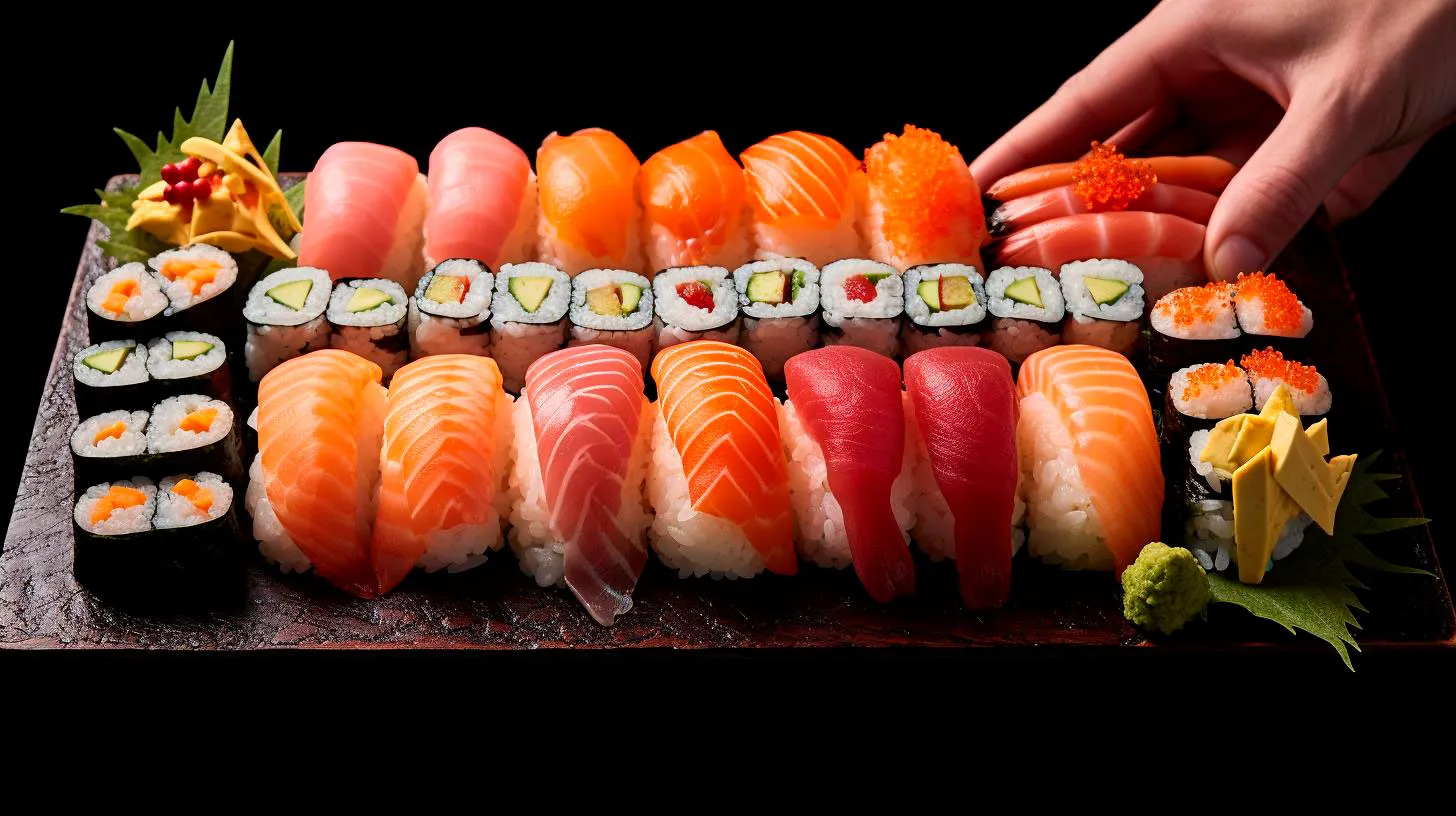Sustainable Sushi: A Guide to Ocean-Friendly Ingredients
In this article, we will explore the world of sustainable sushi and provide you with a guide to ocean-friendly ingredients.
The Importance of Sustainable Sushi
Before we dive into the details, let’s take a moment to understand why sustainable sushi is so important. Overfishing and destructive fishing practices can have severe consequences, including the depletion of fish populations, destruction of marine habitats, and harm to other species in the ecosystem. By choosing sustainable sushi ingredients, we can help protect the oceans and ensure the availability of seafood for future generations.
Key Features of Sustainable Sushi
- Use of sustainably sourced seafood: Look for sushi restaurants and retailers that prioritize sustainably sourced seafood. This means choosing fish that are caught or farmed in a way that minimizes harm to the environment and maintains healthy fish populations.
- Supporting local and responsible fisheries: Opt for sushi made with ingredients sourced from local and responsible fisheries. This helps reduce the carbon footprint associated with transportation and supports communities that practice sustainable fishing.
- Avoiding endangered species: It is crucial to avoid sushi made from endangered species, such as bluefin tuna. These species are already at a high risk of extinction, and consuming them only further contributes to their decline.
- Certifications: Look out for certifications such as the Marine Stewardship Council (MSC) and the Aquaculture Stewardship Council (ASC). These certifications ensure that the seafood has been sourced sustainably and meets strict environmental and social standards.
Sustainable Sushi Ingredients
Now, let’s explore some of the most popular and sustainable sushi ingredients:
1. Alaska Salmon
Alaska salmon is not only delicious but also one of the most sustainable choices for sushi. The Alaskan fishery is well-managed, and the use of sustainable fishing practices ensures healthy fish populations and minimal environmental impact.
Key takeaways:
- High in omega-3 fatty acids, which promote heart health
- Supports local Alaskan communities and their fishing traditions
- Wild-caught and free from antibiotics and hormones
2. Pacific Albacore Tuna
When it comes to tuna, choosing Pacific albacore is a sustainable option. These smaller, younger tuna are abundant and reproduce rapidly, making them a more environmentally friendly choice compared to larger tuna species.
Key takeaways:
- Lower in mercury levels compared to other tuna species
- Rich in protein and essential nutrients
- Supports local fisheries along the Pacific coast
3. Rainbow Trout
Rainbow trout is a sustainable alternative for those who enjoy the taste and texture of salmon. It is often farmed in a responsible and environmentally friendly manner, minimizing the impact on wild fish populations.
Key takeaways:
- High in omega-3 fatty acids and low in saturated fats
- Typically raised without the use of antibiotics and hormones
- Supports local trout farms and reduces the pressure on wild fish populations
4. Farmed Oysters
Oysters are not only a delicacy but also an excellent sustainable choice for sushi. They are filter feeders and help improve water quality, making them beneficial for the marine ecosystem. Look for oysters that are farmed in an environmentally responsible manner.
Key takeaways:
- Rich in nutrients such as zinc, iron, and vitamin B12
- Help to improve water quality and maintain a healthy marine environment
- Support local oyster farmers and their sustainable practices
In Conclusion
Choosing sustainable sushi is a small but impactful step towards protecting our oceans and ensuring the longevity of seafood. By opting for sushi made with ocean-friendly ingredients like Alaska salmon, Pacific albacore tuna, rainbow trout, and farmed oysters, we can enjoy our favorite sushi while also supporting sustainable practices in the seafood industry.
Remember, the choices we make as consumers can have a significant impact on the environment. So, next time you indulge in sushi, choose sustainably and savor the flavors guilt-free!
Exploring Sustainable Sushi: Finding Ocean-Friendly Options
Sustainable Sushi: A Deeper Dive
Before diving into the world of sustainable sushi, let’s first understand what it means. Sustainable sushi refers to the use of ingredients that are sourced in a manner that minimizes harm to the oceans, protects marine wildlife, and supports sustainable fishing practices. It aims to promote the long-term health of our marine ecosystems while satisfying our taste buds.
The Importance of Sustainable Sushi
- Preserving Marine Life: Overfishing poses a significant threat to marine life and ecosystems. By opting for sustainable sushi, we can help protect diminishing fish populations and preserve the delicate balance of our oceans.
- Reducing Bycatch: Unsustainable fishing methods often result in bycatch, which refers to the unintentional capture of non-target species like dolphins, sea turtles, and sharks. Sustainable practices help reduce this unintended harm to marine life.
- Fighting Climate Change: Our oceans play a crucial role in mitigating climate change by absorbing carbon dioxide. However, unsustainable fishing practices and the destruction of marine habitats exacerbate the effects of global warming. By choosing sustainable seafood, we contribute to the overall health of our planet.
Identifying Sustainable Sushi Options
Now that we understand the importance of sustainable sushi, let’s explore some ways to identify ocean-friendly options when ordering or making sushi:
1. Research the Source
When ordering sushi, ask questions about where the seafood comes from and how it was caught. Look for sustainably sourced options, such as wild-caught fish from well-managed fisheries or seafood certified by reputable organizations like the Marine Stewardship Council (MSC).
2. Choose Plant-Based Alternatives
Sushi doesn’t have to be fish-based. Consider trying vegetarian or vegan sushi options that incorporate delicious plant-based ingredients like avocado, cucumber, carrot, or tofu. You might be pleasantly surprised by the burst of flavors!
3. Opt for Local and Seasonal Ingredients
Support local fisheries by choosing sushi with ingredients sourced from nearby waters. Not only does this reduce the carbon footprint associated with transportation, but it also ensures that you’re enjoying the freshest seafood available.
4. Embrace Sustainable Farmed Fish
While the term “farmed fish” might raise concerns, sustainable aquaculture practices can have a significantly lower impact on the environment compared to traditional fishing methods. Look for sustainably farmed options like responsibly sourced salmon or barramundi.
5. Stay Informed through Mobile Apps
Several mobile apps, such as Seafood Watch and FishChoice, provide up-to-date information on sustainable seafood options. These apps help you make informed decisions while dining out or purchasing seafood from the grocery store.
Key Takeaways
- Promote sustainable fishing practices by opting for ocean-friendly sushi.
- Choose sushi made with sustainably sourced seafood or plant-based alternatives.
- Support local fisheries and enjoy fresh, seasonal ingredients.
- Consider sustainable farmed fish options for a low-impact choice.
- Stay informed through mobile apps that provide up-to-date information on sustainable seafood.
Sustainable sushi offers a way for us to indulge in our favorite Japanese delicacy while preserving the health and biodiversity of our oceans. By making conscious choices and supporting sustainable practices, we can ensure that future generations can continue to enjoy the wonders of sushi without compromising the natural environment.
Ocean-Friendly Sushi Making Sustainable Ingredient Choices
The Environmental Impact of Sushi
Traditional sushi ingredients such as tuna, salmon, and shrimp have significant environmental implications. Overfishing is a serious concern, as many fish populations have been depleted to alarming levels. Additionally, the methods used to capture fish often harm other marine life, including turtles, dolphins, and coral reefs.
Another sustainability challenge lies in the rice used to make sushi. Producing rice requires large amounts of water and releases greenhouse gases, contributing to climate change. Moreover, the soy sauce and wasabi we commonly enjoy with sushi also have their own environmental consequences.
The Need for Sustainable Practices
To preserve our oceans and the delicate ecosystems they contain, it is imperative that sushi restaurants and consumers make sustainable ingredient choices. By opting for ocean-friendly alternatives, we can help protect marine life and reduce the carbon footprint of the sushi industry as a whole.
1. Choose Sustainable Fish
The key to ocean-friendly sushi is selecting sustainable fish options. Look for species that are abundant and responsibly sourced. For example, opt for sushi made with sardines, herring, or mackerel, as these fish have healthy populations and are less likely to contribute to overfishing.
- Consult seafood sustainability guides to ensure you make the right choices.
- Support sushi restaurants that prioritize sustainable fishing practices.
- Consider trying vegetarian sushi options, such as avocado or cucumber rolls.
2. Embrace Plant-Based Options
While sushi is traditionally associated with fish, there are delicious plant-based alternatives that provide a sustainable and cruelty-free option. Explore sushi made with ingredients like tofu, sweet potato, and mushrooms, which offer unique flavors and textures.
- Experiment with different vegetables and fruits to create colorful and satisfying sushi.
- Consider adding seaweed salad or marinated tofu as protein-rich fillings.
- Try vegan sushi rolls with ingredients like mango, asparagus, or pickled radish for a refreshing twist.
3. Support Local and Organic Choices
Choosing local and organic ingredients is another way to make your sushi more sustainable. Local seafood reduces the carbon emissions associated with transportation, and organic produce limits the use of harmful pesticides and promotes healthier ecosystems.
- Visit farmers markets to find locally sourced ingredients for your homemade sushi.
- Inquire with sushi restaurants about the origin of their ingredients and their commitment to organic practices.
- Opt for seasonal vegetables and fruits to create sushi filled with fresh and vibrant flavors.
The Benefits of Ocean-Friendly Sushi
Making sustainable ingredient choices in sushi has numerous advantages, both for the environment and for our well-being.
- Preservation of marine ecosystems and biodiversity.
- Reduced overfishing practices and protection of vulnerable fish populations.
- Lower carbon emissions and mitigation of climate change.
- Promotion of healthier and organic food options.
- Diverse flavors and creative combinations with plant-based ingredients.
By embracing ocean-friendly sushi, we can enjoy this culinary delight while playing our part in conserving the oceans, supporting sustainable fishing practices, and promoting a healthier planet for future generations.
Sustainable Sushi Ingredients: How to Choose Ocean-Friendly Options
In this article, we will explore how to make ocean-friendly choices when it comes to sushi ingredients. Let’s dive in!
The Importance of Sustainable Sushi Ingredients
Before we delve into choosing sustainable sushi ingredients, let’s understand why it matters. Overfishing and destructive fishing practices have led to a decline in fish populations, destruction of marine habitats, and imbalanced ecosystems. By opting for sustainable ingredients, you can contribute to the conservation of our oceans and ensure that future generations can enjoy sushi without compromising the environment.
Key Considerations for Sustainable Sushi Ingredients
1. Choose Sustainable Fish
One of the most important aspects of sustainable sushi is choosing fish species that are not endangered or threatened. Opt for varieties that come from well-managed fisheries with sustainable practices. The Monterey Bay Aquarium’s Seafood Watch Program is an excellent resource to help you make informed choices. Look for fish like Alaskan salmon, Arctic char, or responsibly sourced yellowtail.
2. Embrace Plant-Based Options
Sustainable sushi doesn’t necessarily mean it has to contain fish. Vegetarian and vegan sushi options have gained popularity, providing a delicious and eco-friendly alternative. Try ingredients like avocado, cucumber, sweet potato, or tofu to create tasty and sustainable sushi rolls.
3. Use Locally Sourced Ingredients
Support local and sustainable seafood producers by choosing ingredients that are sourced from your region. This reduces the carbon footprint associated with long-distance transportation and promotes the local economy. Freshness is also guaranteed when you go for locally sourced ingredients!
4. Avoid Threatened Species
Some fish species are particularly vulnerable to overfishing and are at risk of extinction. Avoid consuming these threatened species, as it contributes to their decline. The Atlantic bluefin tuna and Chilean sea bass are examples of species that should be avoided due to their critically low populations.
5. Opt for Organic and Responsibly Farmed Options
When it comes to sushi, choosing organic and responsibly farmed ingredients can make a significant difference. Look for organic labels when purchasing ingredients like seaweed, rice, and other vegetables. Responsibly farmed shellfish, such as oysters and mussels, are also excellent sustainable options.
Key Takeaways
- Choose fish species from well-managed fisheries to ensure sustainability.
- Embrace plant-based options like avocado and tofu as delicious alternatives to fish-based sushi.
- Support local producers by using locally sourced ingredients, reducing transportation emissions.
- Avoid consuming threatened species to protect their populations from further decline.
- Look for organic labels and responsibly farmed options to make a positive impact on the environment.
By following these simple guidelines, you can enjoy sushi guilt-free while preserving the health of our oceans. Remember, small changes can lead to significant differences, so choose wisely and make sustainable choices for a better future.



